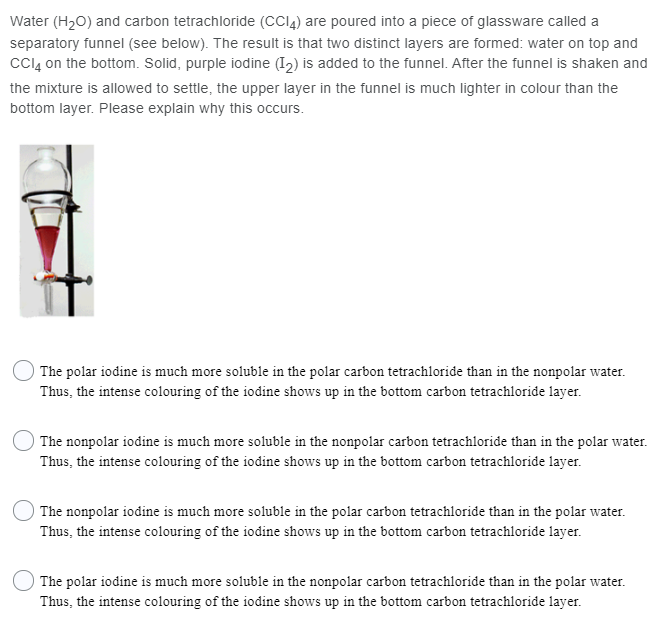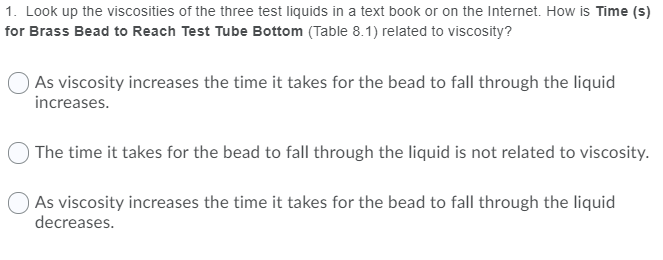Water (H2O) and carbon tetrachloride (CCI4) are poured into a piece of glassware called a separatory funnel (see below). The result is that two distinct layers are formed: water on top and CCI4 on the bottom. Solid, purple iodine (I2) is added to the funnel. After the funnel is shaken and the mixture is allowed to settle, the upper layer in the funnel is much lighter in colour than the bottom layer. Please explain why this occurs. ) The polar iodine is much more soluble in the polar carbon tetrachloride than in the nonpolar water. Thus, the intense colouring of the iodine shows up in the bottom carbon tetrachloride layer. | The nonpolar iodine is much more soluble in the nonpolar carbon tetrachloride than in the polar water. Thus, the intense colouring of the iodine shows up in the bottom carbon tetrachloride layer. | The nonpolar iodine is much more soluble in the polar carbon tetrachloride than in the polar water. Thus, the intense colouring of the iodine shows up in the bottom carbon tetrachloride layer. | The polar iodine is much more soluble in the nonpolar carbon tetrachloride than in the polar water. Thus, the intense colouring of the iodine shows up in the bottom carbon tetrachloride layer.
Water (H2O) and carbon tetrachloride (CCI4) are poured into a piece of glassware called a separatory funnel (see below). The result is that two distinct layers are formed: water on top and CCI4 on the bottom. Solid, purple iodine (I2) is added to the funnel. After the funnel is shaken and the mixture is allowed to settle, the upper layer in the funnel is much lighter in colour than the bottom layer. Please explain why this occurs. ) The polar iodine is much more soluble in the polar carbon tetrachloride than in the nonpolar water. Thus, the intense colouring of the iodine shows up in the bottom carbon tetrachloride layer. | The nonpolar iodine is much more soluble in the nonpolar carbon tetrachloride than in the polar water. Thus, the intense colouring of the iodine shows up in the bottom carbon tetrachloride layer. | The nonpolar iodine is much more soluble in the polar carbon tetrachloride than in the polar water. Thus, the intense colouring of the iodine shows up in the bottom carbon tetrachloride layer. | The polar iodine is much more soluble in the nonpolar carbon tetrachloride than in the polar water. Thus, the intense colouring of the iodine shows up in the bottom carbon tetrachloride layer.
Chemistry & Chemical Reactivity
10th Edition
ISBN:9781337399074
Author:John C. Kotz, Paul M. Treichel, John Townsend, David Treichel
Publisher:John C. Kotz, Paul M. Treichel, John Townsend, David Treichel
Chapter20: Environmental Chemistry-earth's Environment, Energy, And Sustainability
Section: Chapter Questions
Problem 41PS
Related questions
Question

Transcribed Image Text:Water (H20) and carbon tetrachloride (CCI4) are poured into a piece of glassware called a
separatory funnel (see below). The result is that two distinct layers are formed: water on top and
CCI4 on the bottom. Solid, purple iodine (I2) is added to the funnel. After the funnel is shaken and
the mixture is allowed to settle, the upper layer in the funnel is much lighter in colour than the
bottom layer. Please explain why this occurs.
) The polar iodine is much more soluble in the polar carbon tetrachloride than in the nonpolar water.
Thus, the intense colouring of the iodine shows up in the bottom carbon tetrachloride layer.
The nonpolar iodine is much more soluble in the nonpolar carbon tetrachloride than in the polar water.
Thus, the intense colouring of the iodine shows up in the bottom carbon tetrachloride layer.
) The nonpolar iodine is much more soluble in the polar carbon tetrachloride than in the polar water.
Thus, the intense colouring of the iodine shows up in the bottom carbon tetrachloride layer.
) The polar iodine is much more soluble in the nonpolar carbon tetrachloride than in the polar water.
Thus, the intense colouring of the iodine shows up in the bottom carbon tetrachloride layer.

Transcribed Image Text:1. Look up the viscosities of the three test liquids in a text book or on the Internet. How is Time (s)
for Brass Bead to Reach Test Tube Bottom (Table 8.1) related to viscosity?
As viscosity increases the time it takes for the bead to fall through the liquid
increases.
) The time it takes for the bead to fall through the liquid is not related to viscosity.
As viscosity increases the time it takes for the bead to fall through the liquid
decreases.
Expert Solution
This question has been solved!
Explore an expertly crafted, step-by-step solution for a thorough understanding of key concepts.
Step by step
Solved in 2 steps

Knowledge Booster
Learn more about
Need a deep-dive on the concept behind this application? Look no further. Learn more about this topic, chemistry and related others by exploring similar questions and additional content below.Recommended textbooks for you

Chemistry & Chemical Reactivity
Chemistry
ISBN:
9781337399074
Author:
John C. Kotz, Paul M. Treichel, John Townsend, David Treichel
Publisher:
Cengage Learning

Chemistry & Chemical Reactivity
Chemistry
ISBN:
9781133949640
Author:
John C. Kotz, Paul M. Treichel, John Townsend, David Treichel
Publisher:
Cengage Learning

Chemistry: Principles and Practice
Chemistry
ISBN:
9780534420123
Author:
Daniel L. Reger, Scott R. Goode, David W. Ball, Edward Mercer
Publisher:
Cengage Learning

Chemistry & Chemical Reactivity
Chemistry
ISBN:
9781337399074
Author:
John C. Kotz, Paul M. Treichel, John Townsend, David Treichel
Publisher:
Cengage Learning

Chemistry & Chemical Reactivity
Chemistry
ISBN:
9781133949640
Author:
John C. Kotz, Paul M. Treichel, John Townsend, David Treichel
Publisher:
Cengage Learning

Chemistry: Principles and Practice
Chemistry
ISBN:
9780534420123
Author:
Daniel L. Reger, Scott R. Goode, David W. Ball, Edward Mercer
Publisher:
Cengage Learning